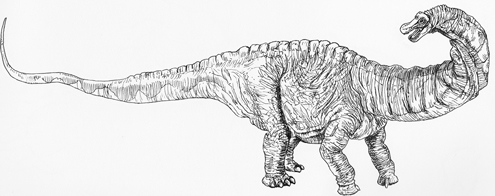Exciting new find of an Apatosaurus
New Apatosaurus near Complete Fossil Found
The small ranching community of Ten Sleep located at the base of the Big Horn mountains in Wyoming, USA is currently the epicentre of a very important dinosaur dig site that is attracting attention from palaeontologists from around the world.
It seems that scientists have unearthed another predator trap site with numerous fossils of herbivorous and carnivorous dinosaurs including a 80% complete Apatosaurus specimen.
Apatosaurus Dinosaur Fossil
The Apatosaurus fossil is a particularly exciting discovery, this animal formerly known as Brontosaurus, may be very well known having appeared in countless books, films and TV but in reality only about a dozen skeletons of this huge long-necked animal have been discovered and most of these have only been about 50% complete at best. The Ten Sleep specimen even has an intact skull and brain case, this is extremely rare as sauropods when they died and the carcase rotted, the heads fell off and those specimens that have been found don’t have much skull material with them. With the delicate skull preserved we can now get a much better understanding of exactly what the face and head of Apatosaurus looked like.
Scientists on the site have nicknamed the Apatosaurus “Einstein” in deference to the head material being intact – although Quantum physics would have been well beyond an 30 Tonne animal over 70 feet long but with a brain the size of your fist.
This 140-million-year-old site also contains the fossils of at least one Allosaurus, leading scientists to speculate that this is a predator trap. Perhaps this was a small pool of water surrounded by sticky mud, when a herbivore like Apatosaurus went down for a drink it got stuck and its cries would have attracted meat-eaters such as Allosaurus looking for an easy meal. The meat-eaters would have closed in but found themselves stuck and sinking too. Over time a lot of animals would have become stuck this way, gradually sinking into the mud and their bodies becoming fossilised.
The predator trap theory is partially confirmed by the position of the Apatosaurus fossils. They are not scattered around the site, but have been preserved in a vertical position, as if the animal died standing up, this is evidence of the Apatosaurus sinking into mud.
We have many Apatosaurus based products in our shop at: Everything Dinosaur.
To view the dinosaur models: Dinosaur and Prehistoric Animal Models.
Predator traps are rare in the fossil record, but are vitally important to palaeontologists. They provide information on entire food webs and ecosystems, giving us far more information than individual specimens. The most famous predator trap from the age of reptiles is the Cleveland-Lloyd Dinosaur quarry in Utah. Since this sites discovery in 1927 over 12,000 dinosaur bones have been unearthed – animals such as the sauropods Barosaurus and Camarasaurus, Stegosaurus, the ornithopod Camptosaurus plus many meat-eaters such as Allosaurus, Ceratosaurus and Stokeosaurus.
Picture credit: Everything Dinosaur
Palaeontologists believe that a volcano in the young Rocky mountains erupted covering a local watering hole with fine ash, leaving a pool of clear water in the middle. As animals came to drink they got stuck in the mixture of ash and mud and were drowned. Dead and dying plant-eaters attracted meat-eaters and this is how the huge number of animals died in the same place. Ironically, the Cleveland-Lloyd site dates back to approximately the same time in the Jurassic as the Ten Sleep site, hence the reason for finding similar animal remains at both locations.


